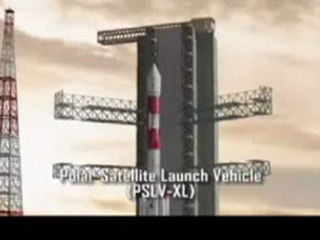India’s moon mission to be up on Wed, final countdown smooth
 Sriharikota (Andhra Pradesh), Oct 21 : With the final countdown progressing without any hitch on Tuesday, India’s maiden unmanned moon mission -- Chandrayaan-I -- is all set to lift off on Wednesday to launch a two-year space odyssey that will catapult the country into an exclusive club of moon-faring nations.
Sriharikota (Andhra Pradesh), Oct 21 : With the final countdown progressing without any hitch on Tuesday, India’s maiden unmanned moon mission -- Chandrayaan-I -- is all set to lift off on Wednesday to launch a two-year space odyssey that will catapult the country into an exclusive club of moon-faring nations.
The weather conditions over the Sriharikota spaceport were being closely monitored and officials said there is no chance of the launch being postponed unless a cylonic threat emerged, as the polar rocket that will put the spacecraft into lunar orbit was being fuelled.
“Everything is going in order. We are ready to launch on the dot,” a space official said, as hundreds of scientists went through the 49-hour countdown drill with precision.
The 1,380 kg spacecraft would be put into orbit by India’s homegrown rocket PSLV-C11, which is due to blast off at at 6.20 AM on Wednesday from the second launch pad at Satish Dhawan Space Centre Associate Director (SDSC).
The work on filling of propellant for the first stage of the polar launch vehicle had been completed and the second stage filling would be over on Tuesday night, SDSC Associate Director Dr M Y S Prasad said.
“The countdown, which started at 5.22 am yesterday, is progressing smoothly and the propellant filling of PS-2 (first stage) has been completed,” he said adding a total of about 43 tonnes of propellant would be filled.
Asked about weather conditions in this space port town, which is witnessing isolated rains, Prasad said the rains would not affect the launch.
“The rain does not matter as the spacecraft is fully rain proof. Even if it is drenched, the launch would take place as per schedule.”
However, the launch might have to be rescheduled if there was cyclonic weather conditions, he added.
Chandrayaan-1 would put India in the elite lunar club comprising Russia, US, Japan, China and European Space Agency, who had undertaken unmanned exploratory missions to the moon.
The mission intends to put an unmanned spacecraft into an orbit around the moon and to perform remote sensing of the nearest celestial neighbour for about two years with eleven payloads
(scientific instruments).
It would reach the moon surface after five and half days. Later, the moon impact probe would be ejected from Chandrayaan-1 to hit the moon surface in a chosen area. (ANI)